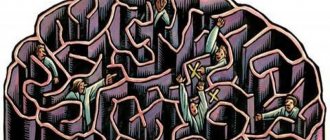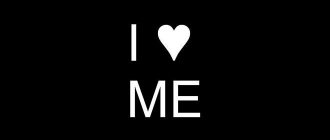Psychoanalysis is a term introduced into psychological use by S. Freud. It is a teaching that focuses on the unconscious processes of the psyche and motivation. This is a psychotherapeutic method based on the analysis of an individual’s implicit, suppressed experiences. In human psychoanalysis, the fundamental source of neurotic manifestations and various pathological diseases is considered to be the pushing out of consciousness of unacceptable aspirations and traumatic experiences.
The psychoanalytic method prefers to consider human nature from the position of confrontation: the functioning of the individual’s psyche reflects the struggle of diametrically opposed tendencies.
What is psychoanalysis
Psychoanalysis is a psychological theory and a method of psychiatric treatment based on it. The basic principles of the concept and the term “psychoanalysis” itself were created by Psychoanalysis. Encyclopaedia Britannica. Austrian psychiatrist Sigmund Freud at the turn of the 19th and 20th centuries.
Psychoanalysis was founded by McLeod S. Psychoanalysis. Simply Psychology. on the belief in the existence of unconscious thoughts, feelings, desires and memories. As a therapy, it is often used to treat depression, phobias, panic attacks, obsessive-compulsive disorder and post-traumatic stress disorder. Psychoanalysis is closely related Brenner GH What Is Psychoanalysis? Psychology Today. with psychodynamic therapy.
Also under psychoanalysis you can use Psychoanalysis. Cambridge Dictionary. understand any of a number of theories about human personality that, based on an analysis of the unconscious in the human mind, attempt to find the underlying causes of mental problems. Psychoanalysis can be described most simply. Encyclopaedia Britannica. this method as “depth psychology”.
There is no general psychoanalytic theory of treatment Safran JD Psychoanalysis Today. Psychology Today. .
More psychoanalysis is possible Brenner GH What Is Psychoanalysis? Psychology Today. considered a form of self-knowledge, a source of new spiritual experiences. If a person spends years sharing his most intimate things with someone who helps him interpret this information, he can look at himself from a completely different perspective.
And finally, psychoanalysis is often considered by Kudryashov I.S. Psychoanalysis and its prerequisites. Journal of Siberian Medical Sciences. as a scientific and philosophical concept. Freud himself believed that psychoanalysis is neither psychology nor philosophy. He called his theory metapsychological, that is, abstract, generalizing, describing psychology itself. — Approx. author. and believed that one day it would become a science. But this was not destined to come true.
In many ways, psychoanalysis was an attempt by I. S. Kudryashov. Psychoanalysis and its prerequisites. Journal of Siberian Medical Sciences. to reconcile the divergent directions in psychology of that time: philosophical and scientific. It eventually evolved into a complex set of ideas and concepts seeking an alternative answer to the question “What is man?”
How did psychoanalysis come about?
The founder of psychoanalysis, Sigmund Freud, was born in 1856 in Austria and spent most of his life Ackerman CE Psychoanalysis: A Brief History of Freud's Psychoanalytic Theory. Positive Psychology. in Vienna. He entered medical school and trained as a neurologist in 1881. Soon he opened a private practice and began treating people with psychological disorders.
Freud's attention was drawn to a case described by his colleague, the Austrian physician and physiologist Joseph Breuer. Breuer's patient, Bertha Pappenheim, known in literature as "Anna O.", suffered from physical ailments for no apparent reason. But she felt better when Breuer helped her remember her traumatic experiences. This case will be described more than once by Freud Z. Famous cases from practice. M. 2007. Freud and other authors.
Freud became interested in the unconscious and in the 1890s, together with Breuer, began studying the state of neurotic patients under hypnosis. Colleagues came to the conclusion that the patients' condition improved when they learned through hypnosis about the real sources of their problems.
Freud also noted Psychoanalysis. Encyclopaedia Britannica. that many patients feel the effect of such therapy without hypnosis. Then he developed the technique of free association: the patient told the psychoanalyst everything that first comes to his mind when he hears words such as “mother”, “childhood”.
Freud also saw a pattern: often the most painful experiences of his patients were related to sex. He suggested that these anxious feelings were a consequence of suppressed sexual energy (libido), manifested in various symptoms. And those, according to Freud, are psychological defense mechanisms.
Using the technique of free association, Freud began to study the meaning of dreams, slips of the tongue, and forgetfulness. He considered Psychoanalysis. Psychology Today. that childhood traumas and conflicts give rise to sexual desires and aggression in a person as an adult.
The goal of Freud's psychoanalytic therapy was McLeod S. Psychoanalysis. Simply Psychology. the release of these repressed emotions and experiences, that is, an attempt to make the unconscious conscious. This healing is called “catharsis.”
Freud insisted that reducing symptoms is not enough; the problem will not be solved until its cause is eliminated.
During sessions of psychoanalytic therapy, the patient lay down McLeod S. Psychoanalysis. Simply Psychology. on a special couch, and Freud himself sat behind, taking notes. This helped both free themselves from social restrictions. To achieve a positive result, sometimes it was necessary to Ackerman CE Psychoanalysis: A Brief History of Freud's Psychoanalytic Theory. Positive Psychology. conduct two to five sessions per week for several years. Sometimes patients, according to Freud Z. Famous cases from practice. M. 2007. Freud himself, experienced memories and associations so vividly, as if they were actually returning to the past. Although, in essence, psychoanalytic therapy is just a frank conversation.
Freud's couch. Image: Robert Huffstutter/Wikimedia Commons
Psychoanalytic and psychotherapeutic factors
Freud emphasized that he developed psychoanalysis as a method of studying the unconscious
, and he considered the therapeutic effect of psychoanalysis only
a by-product
of such research.
Charles Brenner
bluntly wrote that
“no one is going to lie on a couch for 50 minutes five times a week and talk about everything that comes to mind to a stranger without a good enough reason to do so. As far as we know, the only serious motive for this is neurotic suffering and the hope of relief or cure.” But there is no desire to explore your unconscious
. At least, I do not know that any psychoanalyst I know directly spoke about this to their patients at the beginning of analysis.
In psychoanalysis, it is customary to distinguish between psychoanalytic
and
psychotherapeutic
factors.
The psychoanalytic factor is the study of the unconscious ( the “pure gold” of psychoanalysis
).
And psychotherapeutic factors aim to alleviate the patient’s condition, first of all, through support ( “admixtures” to psychoanalysis
).
The predominance of supportive
interpretations (psychotherapeutic factor) relative to
expressive
, insight-oriented ones (psychoanalytic factor) is a characteristic feature of psychoanalytic psychotherapy, distinguishing it from psychoanalysis.
Therefore, psychoanalytic psychotherapy is also called expressive-supportive psychotherapy
.
Very few patients are ready to receive only the “pure gold” of psychoanalysis
.
So psychoanalyst Frederick Perls
escaped from
the “pure gold” of psychoanalysis
and founded a new type of psychotherapy with a lot of “impurities”,
Gestalt psychotherapy
.
It is interesting that, judging by historical facts, Freud was very friendly to patients and could build trusting, close and deep relationships with patients. That is, Freud himself already used “ admixtures
"to psychoanalysis, without which there can be no
therapeutic effect
.
Another distinctive feature of true psychoanalysis, oriented towards the study of the unconscious, is the provision of space
for the patient to explore his unconscious.
It is believed that if the psychoanalyst talks less, this will give the patient the opportunity to independently analyze his unconscious, i.e. work analytically
.
In support-oriented psychoanalytic psychotherapy, much greater activity of the psychotherapist is allowed if the patient needs it. For example, for depressed patients, the silent psychoanalyst
turns out to be a “
dead mother
” (André Greene), resulting in
iatrogenic retraumatization of the patient
.
Judging by the transcripts of psychoanalytic sessions that have come down to us, Freud was not a particularly silent psychoanalyst. However, the silence of psychoanalysts
became the talk of the town. But when the psychoanalyst is silent, the patient lying on the couch, not seeing the psychoanalyst, may fear that the psychoanalyst has fallen asleep.
How psychoanalysis influenced the development of psychology
During the 20th century, psychologists borrowed many of Freud's ideas and observations. This is especially true for Martynenko T.S., Deinekina A.S. The influence of psychoanalysis on modern psychotherapy. North Caucasian Psychological Bulletin. concepts of levels of consciousness, defense mechanisms and stages of psychological development.
Thus, before Freud, dreams were considered a phenomenon not worthy of scientific attention. However, his book “The Interpretation of Dreams” and the concept outlined in it aroused intense interest in this area of human life, which continues to this day.
Freud's further developments were used by Psychoanalysis. Encyclopaedia Britannica. , for example, to create the theory of child psychoanalysis. Pioneers in this area were Melanie Klein and Anna Freud, daughter of Sigmund Freud.
In a slightly different form, Freud's work was continued by Ackerman CE Psychoanalysis: A Brief History of Freud's Psychoanalytic Theory. Positive Psychology. his student Carl Jung, creator of analytical psychology. He disagreed with the teacher on the nature of libido (the energy underlying human aspirations and actions) and the unconscious, as well as the causes of human behavior.
Freud viewed libido only as a source of sexual energy, while Jung argued that it was much broader and included motives from sex to creativity.
Also, Jung did not share Freud's idea that human behavior is dictated only by past experience. He believed that future aspirations also played a significant role.
Jung's work underlies most modern psychological theories and concepts. For example, he introduced Brenner GH What Is Psychoanalysis? Psychology Today. into circulation such well-known terms as “personality archetypes” and “collective unconscious”.
In the middle of the last century, psychoanalysis entered into close interaction with the arts, humanities and philosophy. For example, he provided Elkan O. B., Putra V. A. The influence of psychoanalysis on the cinema of the twentieth century. Bulletin of Tomsk State University. Cultural studies and art history. a great influence on German expressionism, which, in turn, largely determined the emergence of the horror film genre. Freud's concept greatly influenced the work of such directors as Alfred Hitchcock, Federico Fellini, Michelangelo Antonioni, Paolo Pasolini. Freudianism also plays a significant role in the films “Basic Instinct”, “Eternal Sunshine of the Spotless Mind”, “Antichrist”, “Shutter Island”.
Basics
Key points:
- human behavior, knowledge of the surrounding world and experience are determined by internal drives;
- they are irrational and unconscious;
- attempts to understand them cause psychological resistance, which manifests itself in the form of defense mechanisms;
- individual characteristics of behavior and personality depend on events that occurred in early childhood, at different stages of psychosexual development;
- conscious perception of the surrounding world and the material of the unconscious (repressed) come into conflict with each other;
- it leads to various psycho-emotional disorders: neuroses, depression, neurotic character traits, phobias;
- You can free yourself from the area of the unconscious if you become aware of it (but this can only be done with the help of a professional).
These are the basic ideas of psychoanalysis on which work with the patient is based.
What principles underlie psychoanalysis?
Consciousness and unconsciousness
Freud suggested Ackerman CE Psychoanalysis: A Brief History of Freud's Psychoanalytic Theory. Positive Psychology. a model of the human mind consisting of three layers:
- Consciousness is our current thoughts, feelings and aspirations.
- The subconscious (or preconscious) is everything that we remember or are able to remember.
- The unconscious is the repository of what controls our behavior, including primitive and instinctual desires.
Freud considered the unconscious to be a special area Kudryashov I.S. Psychoanalysis and its prerequisites. Journal of Siberian Medical Sciences. psyche, completely different from reality. According to him, the unconscious is divorced from moral attitudes and prejudices; it is a repository of secret desires and hidden experiences. Freud later refined, expanded and structured this tripartite model. This is how the concept of “it”, “I” and “super-ego” appeared.
“It”, “I” and “super-ego”
The study and interpretation of free associations led to Psychoanalysis. Encyclopaedia Britannica. Freud to a new concept of personality structure of three components: “it”, “I” and “super-ego”.
- “It” (id) is the urges and impulses associated with instinctive desires for the continuation of life and destruction. The id exists only at the level of the unconscious.
- “I” (ego) is that part of the personality that is most closely connected with reality and helps a person perceive the world around him, learn new things and satisfy needs. It operates on the conscious and preconscious levels and is formed in infancy.
- The “superego” (superego) is the ideals and values of a person that he has learned from his family, environment and the outside world. The superego acts as a censor of ego functions, indicating how to act is morally acceptable. For the most part it operates at the level of consciousness.
Within the framework of the Freudian concept, conflicts between these components of personality lead to Psychoanalysis. Encyclopaedia Britannica. to anxiety. To protect against it, a person has special mechanisms learned from his family or culture.
Defense Mechanisms
Freud considered Ackerman CE Psychoanalysis: A Brief History of Freud's Psychoanalytic Theory. Positive Psychology. that the components of the mind are in constant conflict because each has its own purpose. When a conflict goes beyond certain limits, a person’s ego triggers defense mechanisms, including the following:
- Suppression - the ego pushes disturbing or dangerous thoughts out of consciousness. A person may simply “forget” about the real cause of his anxiety - for example, a traumatic event in childhood.
- Denial - the ego makes a person not believe in what is happening or refuse to acknowledge it. Thus, parents who have lost a child often do not want to believe that what happened was real.
- Projection - the ego attributes a person's thoughts and feelings to someone else. For example, he transfers hidden fantasies and socially unacceptable desires to other people.
- Displacement - a person redirects his reaction and changes the object that causes tension to another - safer one. The simplest example is an employee who was yelled at by his boss and takes out his anger on a weaker person - a subordinate, a child or a dog.
- Regression - a person rolls back in development in response to negative emotions. For example, a shocked adult behaves like a child.
- Sublimation - like displacement, replaces a person’s unconscious aspirations with work or a hobby. The most famous example is the redirection of sexual energy to creative activities.
When these mechanisms interfere with a person's normal life in society, they become pathological, according to psychoanalysis.
Interpretation
Psychoanalysis avoids Psychoanalysis. Encyclopaedia Britannica. assessment, its essence is in explanation, and not in condemnation or approval. The psychoanalyst is not a mentor, he is a “blank screen”. This is necessary so that the client can work on his unconscious without the interference of others.
To obtain data about hidden experiences and their interpretation, the analyst can use various tools McLeod S. Psychoanalysis. Simply Psychology. :
- Rorschach test (“ink blots”). The blots in the images themselves are abstract and mean nothing. It is important what each individual person sees in them, having projected their unconscious.
- "Freudian slips" (parapraxes). In psychoanalysis, it is believed that slips of the tongue reveal our hidden unconscious desires. For example, a mistake in the name of a sexual partner reveals the real object of the fantasy of the person who misspoke.
- Free association of ideas . Freud used this method to analyze a person's first (unconscious) reaction to words.
- Dream analysis . Freud recognized this method as very important, since he believed that the mind is less vigilant in sleep and allows repressed experiences to come out. Dreams, according to Freudianism, have explicit (what we remember or think) and hidden (what it actually says) meanings.
After receiving the data, the client and analyst jointly express Ackerman CE Psychoanalysis: A Brief History of Freud's Psychoanalytic Theory. Positive Psychology. hypotheses about symbols and the conflicts and experiences hidden behind them. Usually the therapist's job is to point out to the patient the defense mechanisms in his mind and the reasons why they appeared.
Psychosexual development
Freud suggested Ackerman CE Psychoanalysis: A Brief History of Freud's Psychoanalytic Theory. Positive Psychology. that the development of a child is associated with changes in sources of pleasure. Based on this, he identified five stages of psychosexual development.
- Oral : The child seeks pleasure with the mouth (for example, from sucking).
- Anal : The child receives pleasure from the anus (for example, being needy or defecating).
- Phallic : the child receives pleasure from the penis or clitoris (for example, during masturbation).
- Latent (hidden): the child’s sexual motivation for pleasure is weakly expressed or completely absent.
- Genital : development is coming to its logical conclusion; boys and girls get pleasure from the penis or vagina (for example, from sex).
According to Freud, to become a psychologically healthy person with a fully formed ego and superego, one must go through all these stages. Otherwise, you can get stuck on one of them, and this will lead to emotional and behavioral problems in adulthood.
Complexes
Childhood problems, which, according to Freud, became the causes of difficulties in adult life, were structured by the Austrian psychologist in the concept of complexes. The most famous is Ackerman CE Psychoanalysis: A Brief History of Freud's Psychoanalytic Theory. Positive Psychology. Among those described by Freud was the Oedipus complex, when the son unconsciously wants to take the place of his father. The analogue of the Oedipus complex in girls is the Electra complex.
Theory
An analysand is a patient with whom a psychoanalyst works.
Metapsychology is the entire theory of psychoanalysis.
Topographic model of the psyche:
- conscious - its superficial, understandable, visible part;
- unconscious - hidden, incomprehensible, mysterious, unconscious;
- preconscious - borderline, located in the area of the unconscious, but breaking out during certain situations of choice or in dreams.
Structural model of the psyche:
- Id (It) - instinct, obeys the principle of pleasure;
- Ego (I) - contact with the outside world through perception, controls behavior and thinking;
- Superego (Super-I) - moral norms, values based on moral prohibitions and formed in the process of education.
Personality structure according to S. Freud
Stages of psychosexual development - experience that leaves an imprint in the form of moral attitudes, character traits, behavior patterns:
- Oral phase (from birth to 1.5 years) - dominance of the id.
- Anal (1.5-3.5) - the formation of the super-ego under the influence of norms, rules, restrictions, prohibitions.
- Phallic (3.5-6) - increased interest in sex, which most often leads to Oedipus or Electra complexes.
- Latent (6-12) - absence of manifestations, break.
- Genital, adult (from 12 years old).
A protective psychological mechanism is an unconscious mental process aimed at eliminating negative experiences:
- substitute;
- compensatory;
- displacing;
- denying;
- projecting;
- sublimating;
- rationalizing;
- retrogressive.
These are the basic defense mechanisms described by Freud. Today the list has been significantly expanded and includes more than 30 mental processes.
What areas of psychoanalysis exist today?
There are significant differences between Freud's theories and modern psychoanalysis Safran JD Psychoanalysis Today. Psychology Today. . For example, Ackerman CE Psychoanalysis: A Brief History of Freud's Psychoanalytic Theory is not being done in psychology today. Positive Psychology. such a strong emphasis on sex and related behavior. But at the same time, much attention is still paid to the experience of early childhood.
In the second half of the 20th century, Ackerman CE Psychoanalysis: A Brief History of Freud's Psychoanalytic Theory called for the concept of psychoanalysis. Positive Psychology. French psychoanalyst Jacques Lacan returned, offering a new reading of it. He took a different look at the unconscious and, unlike the founder of psychoanalysis, paid more attention to language.
Lacan came to the conclusion that it is the real, and not the unconscious, that must be recognized as the main level of the human mind. Anxiety, according to Lacan, arises from the fact that a person cannot control the reality around him.
Since psychoanalysis had a huge impact on popular culture, some leading representatives of neo-Freudianism (Jacques Lacan, Slavoj Zizek) conduct Elkan O. B., Putra V. A. The influence of psychoanalysis on the cinema of the twentieth century. Bulletin of Tomsk State University. Cultural studies and art history. psychoanalytic research on her works. For example, one of Žižek’s books is called “What You Always Wanted to Know About Lacan (But Were Afraid to Ask Hitchcock).”
As another example of a neo-Freudian concept, Brenner GH What Is Psychoanalysis? Psychology Today. give interpersonal psychoanalysis. He is associated with the names of such researchers as Harry Stack Sullivan and Erich Fromm. They assign a special place in the development of personality to the child’s environment: parents and other people, especially peers.
Another modern direction of Freudian theory is neuropsychoanalysis Psychoanalysis. Psychology Today. . He seeks to combine psychoanalytic concepts with the advances of neuroscientists in the study of the human brain. In this way, researchers are trying to find the basis of emotions, fantasies and the unconscious.
Stages of psychosexual personality development
The oral stage is characteristic of the period of breastfeeding of the baby and consists of unconsciously receiving pleasure in the process of sucking the mother's breast using the mouth and tongue. This stage is the period of manifestation of the “Id”.
The anal stage, which develops at the time of potty training and the process of conscious defecation.
The phallic stage covers the period from 3 to 6 years and during this period there is an active process of formation of the “Ego”.
Latent stage, characteristic of the onset of puberty. During this period, the teenager is busy with his studies, his interests and hobbies, and in terms of his sexual development the situation is absolutely calm.
The genital stage is a stage that coincides with the period of puberty and powerful hormonal changes in the body. At this stage, the formation of the “Super-ego” occurs, which allows you to regulate and restrain the manifestations of the unconscious and instincts, and thereby completes the formation of personality.
Each of the stages described above has a direct impact on a person’s life and contributes to the formation of personality traits, which in turn depend on the success of passing these stages.
Why is psychoanalysis criticized?
Initially, Freud’s developments were accepted by Kudryashov I.S. Psychoanalysis and its prerequisites. Journal of Siberian Medical Sciences. with hostility, and his concept was accompanied by scandalous fame. In particular, Grünbaum A. opposed it. One hundred years of psychoanalysis: results and prospects. Independent Psychiatric Journal. Karl Jaspers, Arthur Kronfeld, Karl Popper and Kurt Schneider.
Although today the concept of psychoanalysis has many supporters, it is subject to serious criticism. Opponents of psychoanalysis doubt its effectiveness, and some researchers even declare Tallis RC Burying Freud. The Lancet. Freudian concept of pseudoscience.
A hot topic of criticism has been the concentration of psychoanalysis on sexual motives. For example, a number of researchers believe Kraepelin E. Introduction to the Psychiatric Clinic. M. 2004. that “rough digging into the sexual life” of patients can lead to adverse consequences for the psyche.
Disputed Kupfersmid J. Does the Oedipus complex exist? Psychotherapy: Theory, Research, Practice, Training. and Freud's concept of the Oedipus complex.
There is also Svartberg, M., Stiles, T.C. Comparative effects of short-term psychodynamic psychotherapy: a meta-analysis. Journal of consulting and clinical psychology. doubts about the effectiveness of psychoanalytic therapy. In 1994, a group of German scientists conducted Hoffmann-Richter U. Psychotherapie im Wandel - Von der Konfession zur Profession. Eine Auseinandersetzung mit einem bemerkenswerten Buch von Klaus Grawe, Ruth Donati und Friederike Bernauer. Psychiatric Praxis. study of 897 works on psychoanalysis. Scientists have concluded that long-term visits to a psychoanalyst are not effective for the patient and that psychoanalytic therapy increases the risk of worsening his condition. Only some mild disorders, according to the article, partially recede after psychoanalysis sessions. At the same time, behavioral therapy was twice as effective.
Noted Ackerman CE Psychoanalysis: A Brief History of Freud's Psychoanalytic Theory. Positive Psychology. also that the hypotheses and provisions of psychoanalysis are difficult to test experimentally, since this approach pays too little attention to the conscious in human behavior.
Psychoanalytic theory has also been criticized for its roots in Freud's sexist views, its inapplicability to non-Western cultures, and its excessive tendency to reduce everything to pathologies.
Opponents also criticize the methods of psychoanalysis. For example, psychologist Burres Frederick Skinner considered McLeod S. Psychoanalysis. Simply Psychology. The "ink blot" method is subjective and unscientific.
In addition, Freud himself is reproached by A. M. Rutkevich. How Freud adjusted the facts to his theory. Psychoanalysis. Origins and first stages of development: Course of lectures. M. 1997. in manipulation of facts. In 1972, Canadian psychiatrist and medical historian Henry Ellenberger found out Ellenberger HF The story of “Anna O”: A critical review with new data. Journal of the History of the Behavioral Sciences. , that there is no improvement in the condition of “Anna O.” Did not happen. That is, the very first case of cure using psychoanalysis actually turned out to be a fake. Subsequent studies established Rutkevich A. M. How Freud adjusted the facts to his theory. Psychoanalysis. Origins and first stages of development: Course of lectures. M. 1997. that Breuer stuffed the patient with morphine and chloral hydrate, ultimately making her a drug addict. Because of this, she spent another three years recovering from the consequences of “catharsis.”
Today it is known that “Anna O.” suffered Borsch-Jakobsen M. Souvenirs d'Anna O. Une mystification, centenaire. Paris. 1995. from dental disease. Freud’s own patient, “Cecilia M.”, also had the same illness. (Anna von Lieben), whom he persistently diagnosed as hysterical neurosis. It is also worth mentioning here the illustrative case of “Dora” (Ida Bauer). Freud believed that her pain was associated with nervous experiences, although in fact Ida was tormented by rectal cancer.
There are also subjective factors McLeod S. Psychoanalysis. Simply Psychology. , which make it difficult to determine whether psychoanalytic therapy is effective or not.
- It requires a lot of time, money and motivation and does not guarantee a quick “recovery”.
- During sessions, a person can reveal repressed painful memories, which will cause him even greater suffering.
- Psychoanalysis is not suitable for all people and not all illnesses.
However, there is Safran JD Psychoanalysis Today. Psychology Today. and the opposite point of view. For example, Canadian-American psychologist Jeremy Safran believes that some methods of psychoanalysis in conjunction with modern research have proven effective. And the American Psychological Association includes Psychoanalysis. APA. psychoanalysis is among its recognized practices and areas of specialist training.
What are the alternatives to psychoanalysis?
Psychoanalysts, unlike psychologists, are not oriented Kudryashov I. S. Psychoanalysis and its prerequisites. Journal of Siberian Medical Sciences. on the natural sciences model in assessing human behavior. In psychoanalysis, a person is not an object, but a subject of study, that is, he studies himself. Therefore, according to supporters of psychoanalytic theory, already accumulated knowledge is not applicable to the study of each individual case.
In fact, an alternative to psychoanalysis was Ackerman CE Psychoanalysis: A Brief History of Freud's Psychoanalytic Theory. Positive Psychology. psychotherapy. It relies on evidence-based methods and is less specific about each individual case. And while a psychotherapist may use several types of treatment, a psychoanalyst usually sticks only to psychoanalysis.
Methods of therapy alternative to psychoanalysis (cognitive, cognitive-behavioral, problem) are focused on McLeod S. Psychoanalysis. Simply Psychology. on reducing negative effects. Psychoanalysis seeks Ackerman CE Psychoanalysis: A Brief History of Freud's Psychoanalytic Theory. Positive Psychology. help a person completely overcome the destructive influence of the unconscious by discovering the original source of the problem.
Psychoanalysis had a huge impact on psychology and psychiatry, but it must be understood that it was a product of its time. Freud's concept was extremely lacking in evidence of effectiveness - the students of the Austrian psychologist had to look for them. And although Freudianism is actively criticized, it served as the foundation for evidence-based psychology, which is so popular now.











